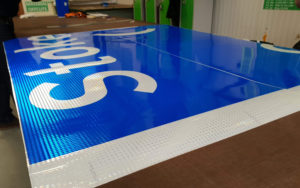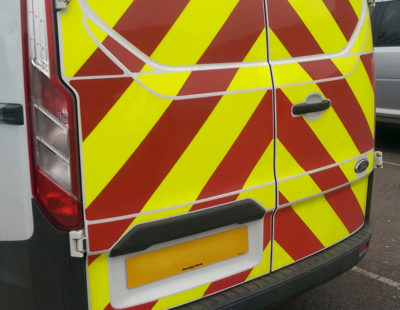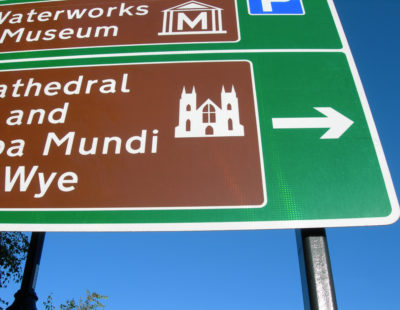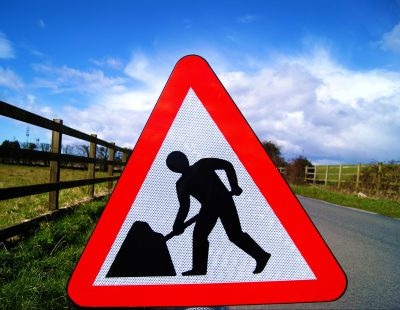Alongside permanent traffic signs – such as regulatory and directional signs – temporary traffic signs have numerous uses too. During street works, temporary traffic disruption, events or other occasions, it may be necessary to use traffic signs to properly divert, instruct, and protect road users and pedestrians for a short period of time. Temporary traffic signs also serve to create safer conditions for those working on roads, protecting them from traffic and outlining safe working areas.
Following our blog on permanent traffic signs regulations, we have created this guide to temporary traffic sign regulations. Below you will find all you need to know about temporary traffic signs, including what defines temporary traffic signs, materials that should be used for traffic signs and explanations of relevant regulations.
Temporary traffic signs definition
Temporary traffic signs are designed to be portable, as they are picked up and put down where and when it is necessary. Unlike permanent traffic signs, which are often secured to posts, temporary traffic signs usually have a free-standing design, which must be stabilised against wind. Although this design may seem robust, temporary traffic signs should not present a collision hazard if placed in an area at risk of vehicle collisions. Ballast weights may be used to provide additional stability in high wind conditions (according to BS 8442:2015, see section below), which the sign manufacturer may advise on.
Temporary traffic signs are used during short-term situations that require additional signage for the safety and instruction of traffic, such as roadworks, a temporary obstacle (i.e. a broken-down vehicle), emergency services intervention, traffic light faults, event parking control, road closures, lane closures and so on.
Although ‘temporary’, these signs may be in situ for many months, or even years, depending on the length of the works or disruption. Temporary traffic signs should be in place only for the duration they are needed and should be removed upon the work’s completion.
More information can be found via the REMA (Retroreflective Equipment Manufacturers Association) information bulletin on temporary signs.
Temporary traffic signs regulations
As well as keeping road users safe, traffic signs are important for any workers on the road too. Employers have a duty of care to ensure their staff and others around them are safe. Part of this duty is complying with legislation and actively enacting correct procedure.
Traffic signs regulations and general directions (TSRGD)
The Traffic Signs Regulations and General Directions (2016) were compiled by the Department of Transport and form key legislation in regard to traffic signs. TSRGD outlines the testing and requirements for all traffic products on UK roads, setting the standard for ‘fit-for-purpose’.
The document includes updated regulations on traffic sign lettering, characters, formats, processes, and applications. Any retroreflective temporary traffic signs must be in accordance with the most recent TSRGD publications. Find advice on temporary traffic signs specifically in section 3 and schedule 13.
Reflectivity of traffic signs is a minimum requirement for enhanced visibility (see BS 8442:2015 below). Retroreflective materials can be applied to metal, plastic, or flexible backings, then attached to self-supporting portable frames, ballasted if needed.
Traffic signs manual
Consisting of eight chapters, the Traffic Signs Manual gives guidance on the use of traffic signs and road markings for traffic authorities. The manual was also created by the Department of Transport and gives actionable guidance on traffic signs in line with TSRGD regulations.
Chapters within the Traffic Signs Manual are divided according to sign type and application, i.e. Chapter 4 Warning Signs and Chapter 8 Road Works and Temporary Situations.
View the Traffic Signs Manual >
Chapter 8: Traffic Signs Manual
Within the Traffic Signs Manual, there are specific regulations regarding vehicle and personal safety for temporary street works, outlined in Chapter 8 of the Traffic Signs Manual. This chapter provides a comprehensive guide to best practice at temporary street works, including the use of temporary traffic signs for the duration of the works (Chapter 8 Part 1). The chapter includes guidance on preparation, operation, and considerations for temporary street works to ensure the safety of all workers and road users.
Failure to comply and properly ensure signage and other safe working practices at street works can cost lives. There are also financial and legal ramifications to non-compliance.
Chapter 8 outlines the need for fit-for-purpose signage that meets the standards prescribed by TSRGD to be set out around works on roads. Other advice covers the setting out, positioning, and use of temporary traffic signs, including unobstructed view, availability of early and immediate warning, and secure placement.
Chapter 8 specifies the use of R1 and R2 grade reflective materials on temporary traffic signs on urban/rural (lower speed) roads. In 2020, Chapter 8 guidance was updated (Part 3: Update) to offer further clarification and detailed advice. The update also included the specification of R3B, micro prismatic reflective materials on high-speed highways. Find out more about the range of high-quality reflective materials we provide at Lakeside.
See more: REMA Issues Updated Best Practice Guide to Chapter 8 and ECE104 Markings and Materials
In the Safety at Street Works and Road Works code of practice, a popular industry code, Chapter 8 is mentioned. The Department of Transport published the code of practice to demonstrate best practice when undertaking temporary street works. In regard to temporary traffic signs, the code dictates that sign faces must be reflective, other than black parts, in accordance with relevant British Standards.
Safety at Street Works Code of Practice >
BS 8442:2015
British Standard 8442:2015 covers miscellaneous road traffic signs and devices, including requirements and test methods. This standard is relevant to temporary traffic signs as well as flap signs, “Stop/Go” and “Stop/Works” signs, internally illuminated posts and more. It is called up in TSRGD and specified tests must be undertaken for temporary traffic signs to be deemed appropriate for TSRGD.
BS 8442:2015 also outlines various performance requirements for retroreflective material and classes of performance, from RA1 to R3.
Compliant temporary street signs with Lakeside Group
At Lakeside, we offer a range of high-quality, up to standard retroreflective materials and road traffic products. Whether you need advice on your temporary traffic signs, or want to find compliant high intensity prismatic products, Lakeside can help! As members of REMA, we are proud to be instrumental in the creation of various guidance documents, ensuring our team have comprehensive knowledge of all relevant standards and regulations.
Take a look at our temporary traffic sign products >
Find out more about the range of reflective materials we provide of all grades >
Get in touch with one of our expert team today for more information on any of our products or services.




